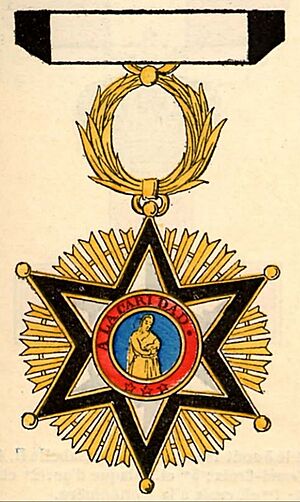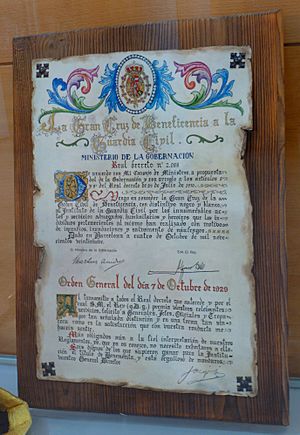Order of Beneficence (Spain) facts for kids
Quick facts for kids Order of Beneficience |
|
|---|---|

"To Charity"
|
|
| Awarded for | To reward actions or services considered extraordinary performed in the course of public calamities. |
| Date | May 17, 1856 |
The Civil Order of Beneficence was a special award in Spain. It was given to people who did amazing things. These actions were usually during big disasters or health problems. Queen Isabella II created this award on May 17, 1856. Later, it was replaced by a new award in 1989.
Contents
History of the Award
Before the Civil Order of Beneficence, there was an award called the Cross of Epidemics. It started in 1838. Then, on May 17, 1856, Queen Isabella II created the Civil Order of Beneficence. A 'royal decree' is like a special rule or law made by the king or queen.
In 1910, these two awards joined together. They were both called the Civil Order of Beneficence. The main goal was to honor people. It recognized those who helped during health crises or epidemics.
In 1943, the Cross of Epidemics was brought back. It was renamed the Civil Order of Health. This separated it from the Civil Order of Beneficence. Since 1983, the Civil Order of Health has been the main award for health services.
Who Could Receive the Award?
People or groups, from Spain or other countries, could receive this award. It was a personal honor. This means it could not be passed on to someone else. If a company or group received it, the award would last for twelve years.
Receiving the award meant you were a member of the Civil Order of Health. You would get special recognition and could show off the award. You could also mention it in your documents. However, the award could not be used to sell products or services.
Changes to the Award's Design
When it first started, the Civil Order of Charity had three levels.
- The First Class Cross was a special badge.
- The Second Class Cross was worn around the neck with a ribbon.
- The Third Class Cross was worn on the chest, like a medal.
In 1910, the award changed. A new, higher level was added. This was called the Grand Cross with Badge. The look of the awards also changed. Different colored ribbons were introduced for each type of service:
- Black and White Distinctive: This recognized brave actions. These actions involved personal risk. People who received this were called "Illustrious."
- Purple and White Distinctive: This was for acts related to public health. Recipients were called "Sir" or "Madam."
- White Distinctive: This was for other extraordinary services.
The Grand Cross with Badge came with the title of "Excellency." The First Class Cross gave the title of "Illustrious." The Second Class Cross gave the title of "Sir" or "Madam."
When the Award Ended
The Civil Order of Charity was stopped in 1931. It was brought back in 1940 during Franco's time. It finally ended on April 17, 1989. A new award, the Civil Order of Social Solidarity, took its place.
Famous Awards
The Coat of Arms of the city of Santa Cruz de Tenerife has the First Class Cross of the Civil Order of Beneficence on it. This was given to the city in 1893. Queen Regent Maria Christina of Austria gave it to them. It was for their brave actions during a cholera outbreak.
In 1929, the Civil Guard and the Carabineros also received a special award. They got the Grand Cross with Black and White Distinctive. This was for their help during fires and floods. This is why the Civil Guard is sometimes called "benemérita." This word means "well-deserving" or "honorable."
See also
 In Spanish: Orden de la Beneficencia (España) para niños
In Spanish: Orden de la Beneficencia (España) para niños
- Orders, decorations, and medals of Spain
- Beneficence



